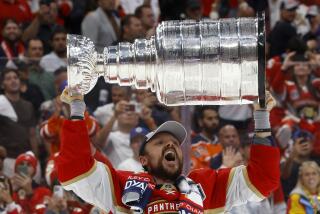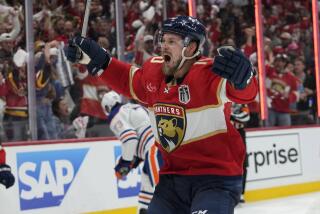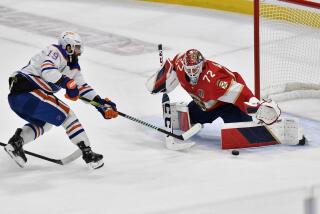Stanley Cup FINALS : The Basic Elements of Hockey
- Share via
The Stanley Cup was first awarded in 1893 as the emblem of hockey supremacy in Canada, with the Montreal Amateur Athletic Assn. the victor. The Toronto Arenas won the Cup at the end of the NHL’s first season, 1917-18. Not until 1928, when the New York Rangers won, did an NHL team from the United States win the Cup. And not until 1993 have the Cup finals come to California. To a hockey fan, the Forum has generally meant the building in Montreal opened in 1924, where the Canadiens have played during their 22 NHL championships. Add another Forum to Stanley Cup history. Tonight, the Kings play host to the Canadiens in Game 3 of the Cup finals. A look at some of the elements of the game.
The Rink
A standard ice hockey rink is roughly half the size of a football field. It is usually 200 feet long by 85 feet wide with rounded corners. A four-foot white wooden wall -- called the borads -- surronds the rink. A protective glass shield extends vertically from the borads. The rink is divided into three zones: across each end of the rink, 10 feet from the boards.
A. End zone faceoff spot and circle
B. Faceoff spot
C. Center line faceoff spot and circle
D. Center line
E. Blue line
The Positions
1. Goal Tender
2. Right defense
3. Left defense
4. Left wing
5. Center
6. Right wing
The Puck
The puck is made of volcanized rubber or other approved material. Approximate weight: 6 ounces.
The Goal
The goals are 6 feet wide by 4 feet deep. The posts and crossbars are red. The goal sits at the middle of the goal line, which is 10 feet fromt he boards
Icing
Icing is called when (1) the puck is passed from behind the center line to beyond the opponent’s goal line (2) without being touched. The call is made once an opponent touches it beyond the line. The call results in a faceoff from the zone where the pass was started. Icing is not called against teams that are a man down.
Offside
A player is offside (1) when the puck is passed across the centerline into the attacking zone and both his skates (2) are beyond the blue line, or when the puck is passed from the defending zone (3) past the center line and both his skates are beyond the center line. Generally results in a faceoff from zone where pass was started.
Penalties
Penalties are as much a part of hockey as slap shots, though in the playoffs, players tend to spend more time playing and referees tend to swallow their whistles on marginal calls. A look at some of the more common penalties.
1) High sticking
Carrying the stick above shoulder height. A minor penalty (two minutes) is assessed at referee’s discretion; a major penalty (five minutes) is assessed if fouled player is cut with the stick.
2) Cross checking
Hitting the opponent with the stick with both hands on the stick and no part of the stick on the ice. Minor penalty.
3) Hooking
Trying to stop or slow down an opponent by hooking with the stick. A minor penalty.
4) Spearing
Poking an opponent with the point of the stick. A major penalty.
5) Slashing
Swinging the stick to impede or intimidate an opponent. A minor or major, depending on discretion of referee.
6) Tripping
Can be with the stick, hand, knee, foot or arm. A minor penalty unless done from behind on breakaway with only goaltender defending, which then calls for a penalty shot.
More to Read
Go beyond the scoreboard
Get the latest on L.A.'s teams in the daily Sports Report newsletter.
You may occasionally receive promotional content from the Los Angeles Times.






